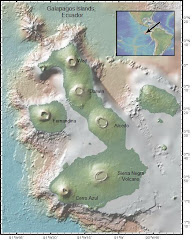After returning soaked, boots and all, from Caleta Iguana, there was time for reflection as we sailed past Cerra Azul volcano and out of the clutches of the garua. It would take days to dry out our clothes. Falk didn’t even make the attempt. On the way back to Pirata in the panga, he quietly set his socks free in the ocean. The day’s work could be considered a miserable experience. So could yesterday’s. Not everyone would enjoy this. We had to be resilient, problem solvers at every station. We faced variables at every landing site. Nothing ever went exactly to plan. That is the nature of field work. Those were some of my fleeting thoughts. But, as we approached the sunshine, it was the compensating factors, sunrises, sunsets, active volcanoes, marine iguanas, penguins, sea turtles… that came to mind. And, as scientists, we are answering important questions. There is excitement in that.
Some of the biggest compensating factors on this field excursion have proved to be the Pirata and her crew. They earned our respect by carefully stowing all of the awkward geophysical gear for our ocean voyage. They demonstrated their seamanship by keeping us safe on the open ocean and skillfully guiding us to our landing sites. We ate well and slept well. Most importantly, onboard we became part of the culture of the Galapagos. Both the ship and crew are natives.
The story of the Pirata is best told by the photos. It is, however, worth putting this image into words. It is Elizabeth Bay, where you can sit on the deck while the suns sets and listen to the bark of sea lions. Just by turning your head you see five active volcanoes, Fernandina, Cerra Azul, Sierra Negra, Alcedo and Darwin. For me that was the Galápagos.

